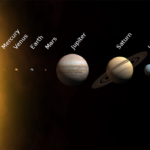The Moon's True Colors: It's Complicated At first glance, the moon might seem to be a simple, silvery-white celestial body. But if you look closer, you'll find there's more to it than meets the eye. First off, it's essential to know that the moon doesn’t emit its own light. Instead, it reflects light from the sun. Up close, the moon’s surface is mostly grey like worn … [Read more...]
What Color is the Moon?
Which Planets Have Rings?
Did you know that Jupiter, Uranus, and Neptune also have their own ring systems too. Even Earth had a small ring system in the past, and Mars may get one in the future. So, which planets have rings now, and which planets had them before? And, will any of the planets get rings in the future? Saturn Saturn is perhaps the most famous planet with rings, and … [Read more...]
How Many Earths Can Fit Inside the Sun?
The quick answer to "How Many Earths Can You Fit In The Sun? Answer: You could fit about 1.3 million Earths inside the sun. Incredible, isn't it!! The sun is a gigantic star that is at the center of our solar system. It is one of the most important objects in our galaxy, and it is responsible for keeping our planet warm and providing the light we need to survive. But … [Read more...]
Why don’t we feel Earth move?
The Earth is constantly moving, but you might be wondering why you can't feel it. Well, it turns out that the Earth is moving very smoothly, and so are you! You see, the Earth rotates on its axis, which is an imaginary line that runs through the center of the Earth from the North Pole to the South Pole. It takes about 24 hours for the Earth to make one full … [Read more...]
How long would it take to get to Pluto?
Following Pluto's 'demotion' to dwarf planet status, a few positive things happened. It got people thinking about this area of the Solar System, how little we knew about it and, with the discovery of a few more similar sized objects, what else could be lurking around out there. Given it's sheer distance from Earth, are there any missions planned to return to this area of space? … [Read more...]


